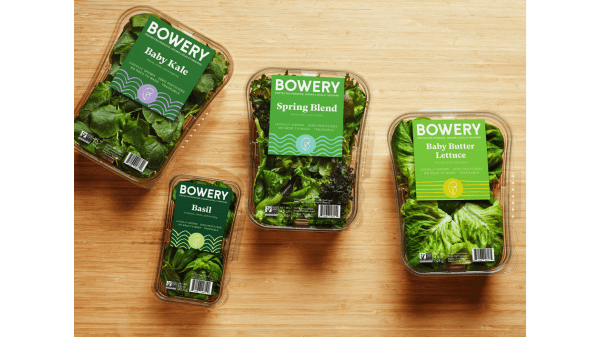Fitting into the urban landscape is Bowery Farming, Inc., a New York City-based startup founded in 2015 by Irving Fain.
Bowery has grown from an initial site in Kearny, NJ to become the largest vertical farming company in the United States, with a second farm in Nottingham, MD, and another opening in Bethlehem, PA this year.
The company has secured multiple infusions of capital to expand its operations.
“Our founder was intrigued by how agriculture has been at the intersection of so many critical issues and decided it was the place he wanted to build his next company through the lens of technology,” explains Bowery’s chief commercial officer, Katie Seawell.
Vertically grown, with plants stacked from floor to ceiling, the company uses LED lighting that mimics sunlight, combined with automation, robotics, and data to deliver the inputs the plants need to optimize output.
This output comprises 13 SKUs across lettuces and herbs, from single-cultivar leafy greens, arugula, and kale to parsley, cilantro, and basil with a 25- to 30-day growth cycle.
Core to the business is the Bowery Operating System, a proprietary technology that serves as the brain of the operation, integrating sensors, vision systems, robotics, automation, and data, while managing the entire workflow of the farm.
“The operating system was built because there was nothing off the shelf that could do what we needed it to do,” notes Seawell.
“Automation, robotics, and water moving vertically and horizontally historically don’t go well together, so key for us was to understand what was happening at every stage of the process to get the flavor profile, quality, and yield,” she explains.
To further this cause, Bowery has a state-of-the-art R&D facility in Kearny focusing on moving beyond leafy greens and herbs to soft fruits and vine crops.
“The goal is to be a meaningful player in the produce category, both nationally and globally,” Seawell says.
“We’re building smart indoor farms, close to the cities we serve,” she adds. “We think there are huge benefits in terms of reducing food miles and extending shelf-life, which enhances freshness, flavor, and nutritional value.”
This is an excerpt from the Applied Technology feature in the March/April 2022 issue of Produce Blueprints Magazine. Click here to read the whole issue.



